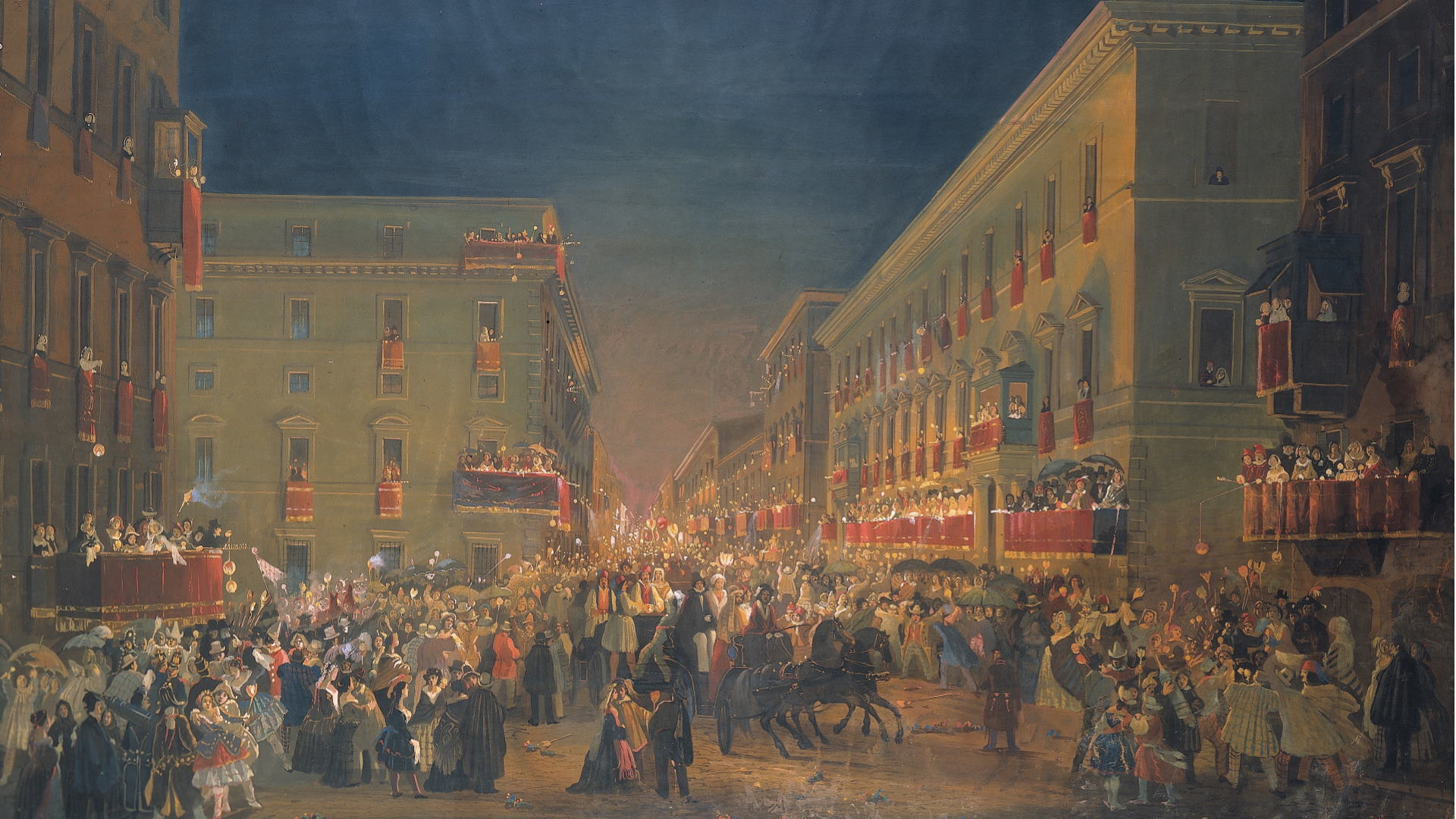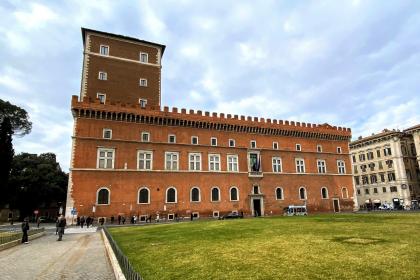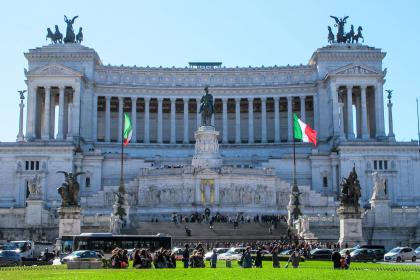
Permis de transgresser
Période de joyeuse folie collective où les règles strictes du quotidien sont abolies et où tout est permis - le jeu, la plaisanterie et les faux-semblants - avant que le mercredi des Cendres ne marque le début des jeûnes du Carême et de la pénitence purificatrice qui précède la Pâque. Le carnaval est, par essence, une fête liée au monde catholique et chrétien. Pourtant, selon de nombreux observateurs, il trouve son origine directe dans les anciennes Saturnales, célébrées à Rome jusqu'à la fin de l'époque impériale et ponctuées de banquets, de sacrifices, de danses et de déguisements avec des masques : une poignée de jours où le monde était bouleversé, où les différences sociales étaient annulées et où les esclaves pouvaient temporairement se considérer comme des hommes libres.
Palios, joutes et viande à volonté
Oubliez un instant les fastes de Venise, de Viareggio ou d'Ivrea : il fut un temps où Rome était aussi aux commandes du carnaval - un temps très long, qui remonte au Moyen Âge. Des sources nous apprennent qu'au XIIème siècle, pendant le « ludus carnevalarii », le pape arrivait à cheval jusqu'au Testaccio, accompagné du préfet et des chevaliers de la ville, pour assister aux cérémonies propitiatoires, tandis que les familles nobles de Rome et des villes voisines se livraient à des duels, des tournements, des joutes, des tauromachies et d'autres combats d'animaux. Toute la ville envahissait les rues, non seulement pour assister à ce tourbillon de spectacles et d'exhibitions, mais aussi pour s'approvisionner en viande gratuite. L'un des événements les plus attendus par la population était la « ruzzica de li porci » (course de cochons) : des hauteurs du Mont sacré des Cocci, on lançait des charrettes transportant des cochons, tandis que dans la vallée, les gens se disputaient les animaux, morts ou vivants. Des tournois de cavaliers étaient également organisés sur la Piazza Navona, alors appelée « platea in Agone ».
La route du carnaval
Pour que Rome devienne la capitale mondiale du carnaval, il faut cependant attendre le milieu du XVème siècle, lorsque le cardinal vénitien Pietro Barbo monte sur le trône pontifical sous le nom de Paul II. Homme énergique et entreprenant, mais aussi amoureux du luxe, le cardinal fit construire le grand palais qui orne la Piazza Venezia et y installa sa résidence. La place centrale de la ville, et du carnaval, devint donc à partir de ce moment la voisine Via Lata, prolongement urbain de l'ancienne Via Flaminia : c'est là que fut inauguré, le 9 février 1466, un carnaval aux somptueux contours Renaissance, avec des cortèges allégoriques inspirés de la tradition romaine et de la mythologie classique, le tout pour le prix pharaonique de 400 florins d'or. Mais la longue ligne droite qui mène de la Porta del Popolo à la Piazza Venezia se prête également à un autre type d'événement : c'est à partir de ces compétitions singulières que la Via Lata prend son nom moderne de Via del Corso. Par une bulle spéciale, le pape établit que chacun des huit jours non fériés de la période du carnaval donnerait lieu à une course. Chevaux, ânes et buffles s'affrontaient, ainsi que jeunes gens, vieillards, enfants et juifs : un spectacle moqueur, bizarre et grotesque, aussi sauvage que le carnaval des origines, qui fut partiellement interrompu en 1667 par le pape Clément IX.
La course berbère
La course reine, qui dura sans changement à quelques exceptions près jusqu'en 1882, fut cependant toujours celle des chevaux berbères, des chevaux rapides d'origine africaine, spécialement sélectionnés et entraînés. Les chevaux sans jockeys, étaient regroupés sur la Piazza del Popolo et c'est là qu'avait lieu le départ ou « mossa ». Excités et énervés par des épingles insérées dans des boules de poix, les chevaux étaient en effet lancés au milieu des cris de la foule dans une course furieuse et échevelée le long de la ligne droite (« carriera ») jusqu'à la Piazza Venezia, où une banderole marquait la fin du parcours. Là, les chevaux étaient arrêtés avec beaucoup de difficultés par les barbares, les garçons d'écurie (« ripresa »). Parmi les propriétaires des chevaux, on trouve bien sûr les noms de l'aristocratie romaine la plus en vue (comme les Altemps, les Gabriellis, les Rospigliosi), mais il ne manque pas de simples passionnés ou de petits commerçants : le vainqueur est récompensé par une draperie de tissu précieux, financée de force par la communauté juive. L'événement est si attendu que les places le long du parcours sont disputées longtemps à l'avance. Les plus riches et les plus puissants assistent au spectacle depuis les tribunes construites sur la place ou depuis les belvédères et les balcons des palais, ornés de tentures et de brocarts et souvent loués à prix d'or, tandis que les moins fortunés n'ont plus que les pentes bondées du Pincio à leur disposition. Il va sans dire que la furieuse volée de chevaux, combinée à l'excitation d'une foule avide de sensations fortes, ne manquait pas de provoquer des accidents, même mortels.
« Mor'ammazzato chi nun porta er moccolo »
Alors que le carnaval touchait à sa fin, au coucher du soleil du mardi gras, un dernier exploit marquait la fin des festivités : un fleuve de lumières et de personnes envahissait le Corso au cri de « Mor'ammazzato chi nun porta er moccolo » (Celui qui ne porte pas la chandelle doit mourir assassiné). C'était la Festa dei moccoletti (fête des chandelles) : pour y participer, il fallait sortir de chez soi déguisé et porter une chandelle (une torche, une lanterne ou même un lampion), appelée « moccoletto », qu'elle soit aussi fine qu'une « queue de rat » ou aussi grande qu'un « cierge de Pâques ». Dans une frénésie presque sauvage, chacun essayait d'éteindre la lumière de son voisin tout en gardant la sienne allumée. Ceux qui se retrouvaient sans lumière devaient enlever leur masque et devenaient la cible d'insultes et de moqueries, qu'ils soient d'origine noble ou roturière. Cette fête, née à la fin du XVIIIème siècle, représentait une sorte d'enterrement symbolique du carnaval et avait une forte signification rituelle et symbolique. Mais dans la foule, protégée par des masques, tout arrive : farces impitoyables, vols, coups de couteau, trahisons conjugales.
Les masques en liberté
Les masques eux-mêmes contribuaient grandement à l'atmosphère de liberté et d'excentricité du carnaval, dans laquelle l'identité personnelle, le sexe et le statut social disparaissaient comme par enchantement. Parmi les masques traditionnels, citons Rugantino, la brute du Trastevere reconnaissable à son pantalon usé et à son éternel foulard autour du cou, Meo Patacca, le noble crédule Cassandrino, Don Pasquale de' Bisognosi, le docteur Gambalunga, le général Mannaggia la Rocca qui, à la tête d'une armée de miserables, se vante d'actes héroïques jamais accomplis, le gitan et la Pulcinella romaine, manifestement inspirée de Naples. Personne ne renonce à se déguiser : ceux qui n'ont pas les moyens de s'offrir un vrai costume ont recours à la fantaisie, mais les notables, les artistes célèbres, les hommes de lettres et les musiciens succombent aussi à l'attrait du déguisement. En 1821, le déguisement du futur ministre italien Massimo d'Azeglio, de Gioacchino Rossini et de Nicolò Paganini en musiciens ambulants aveugles est entré dans l'histoire : sur une musique composée par Rossini, d'Azeglio chantait une comptine et les autres l'accompagnaient à la guitare en se déguisant en femmes. Et lors du carnaval de 1827, Giuseppe Gioacchino Belli parcourut le Corso en calèche, clamant haut et fort son « elixire nuperrimo » capable de guérir une infinité de maux.
Quatre siècles d'extravagantes folies
Avec ses cortèges, ses défilés, ses danses, ses lancers de « confettis » (boules de craie colorée) et de « sbruffi » (les confettis d'aujourd'hui), ses farces, ses fêtes, ses spectacles et ses somptueux banquets publics, le carnaval romain a été pendant plus de quatre siècles un événement colossal qui a conditionné la vie, les divertissements, la culture et l'art de la ville. Il a attiré et impliqué des peintres, des poètes, des écrivains (Sangallo, Bramante, Raphaël, Michel-Ange, Tasso, Goldoni et bien d'autres) mais aussi de célèbres voyageurs étrangers en visite dans la ville. Le climat d'euphorie collective de cet événement, son atmosphère et sa couleur n'ont pas manqué d'impressionner, entre autres, Stendhal, Dumas, Dickens et Andersen. Goethe, qui participa au carnaval de 1788, le décrivit comme « une fête que le peuple s'offre à lui-même » où chacun peut être aussi « fou et extravagant qu'il le souhaite » et où « à l'exception des coups de fouet et des coups de couteau, tout est permis ». L'élément fondamental et irremplaçable était en fait le peuple romain dans sa vitalité sanguine, son inventivité et son regard ironique et désenchanté. Le déclin du carnaval ne commence qu'avec l'arrivée des Savoie à Rome en 1870 : pour des raisons de sécurité, de nombreuses festivités coutumières, considérées comme responsables d'incidents dramatiques (la race berbère, surtout), sont progressivement interdites. Le changement de Palais était en effet trop récent pour permettre, même sous forme de plaisanterie, de renverser le nouvel ordre.
Image de couverture : Sovrintendenza Capitolina - Ippolito Caffi, Festa dei « Moccoletti » al Corso, 1845-1847, Museo di Roma in Trastevere
Les recettes traditionnelles du carnaval romain

Palazzo di Venezia

 Condividi
Condividi
Place Venezia

 Condividi
Condividi
Piazza del Popolo

 Condividi
Condividi











































